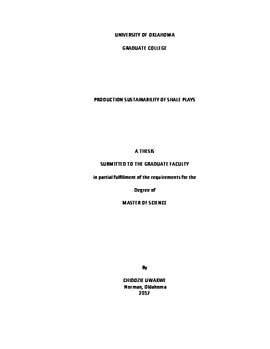| dc.contributor.advisor | Moghanloo, Rouzbeh Ghanbarnezhad | |
| dc.contributor.author | Uwakwe, Chidozie | |
| dc.date.accessioned | 2017-05-15T15:49:47Z | |
| dc.date.available | 2017-05-15T15:49:47Z | |
| dc.date.issued | 2017-05-12 | |
| dc.identifier.uri | https://hdl.handle.net/11244/50865 | |
| dc.description.abstract | Shale reservoirs are commonly observed to have high initial flow rates followed by the occurrence of rapid declines in these rates early in their productive lives. There is, therefore, a need for terminology which describes not only the declines in these reservoirs but their general production performance. This terminology should be related to the petrophysical properties of shales as well. Numerous studies suggest that the early declines in production rates may be due to the limiting factor of the low pore connectivity of the shale matrix. They reason that pore connectivity impacts production by controlling the dispersion in the shale matrix. Pore connectivity is, therefore, an important parameter in analyzing shale resources.
Sustainability, a new notion is introduced as a means of simultaneously evaluating the production rate declines and the performance of these reservoirs. In this study, it is evaluated using plots of q/qmax versus G_p/EUR derived from the production data of the Barnett, Haynesville, and Marcellus shale reservoirs. Reservoir-scale connectivity is also evaluated for these three reservoirs in this by comparing their well production data to reservoir simulation-generated data from models matching the properties of these reservoirs. Areal maps of sustainability and connectivity are generated to view spatial trends and a possible relationship between these two parameters is investigated.
The estimated reservoir-scale connectivity values were fairly low compared to the results from other studies. This may have been the case because the connectivity values estimated were not corresponding to values of initial connectivity but rather values which had declined from their initial levels to some extent due to gas production. Sustainability was observed to be proportional to connectivity, confirming the notion that low connectivities in the matrix lead to higher declines in production rate. The Barnett was observed to have the highest connectivity and sustainability while the Marcellus was observed to have the lowest, with the Haynesville estimates falling in the middle. | en_US |
| dc.language | en_US | en_US |
| dc.subject | Sustainability | en_US |
| dc.subject | Shales | en_US |
| dc.subject | Connectivity | en_US |
| dc.subject | Production | en_US |
| dc.title | Production Sustainability of Shale Plays | en_US |
| dc.contributor.committeeMember | Devegowda, Deepak | |
| dc.contributor.committeeMember | Misra, Siddharth | |
| dc.date.manuscript | 2017-05-11 | |
| dc.thesis.degree | Master of Science | en_US |
| ou.group | Mewbourne College of Earth and Energy::Mewbourne School of Petroleum and Geological Engineering | en_US |
